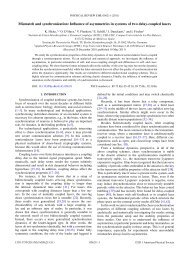DBI Analysis of Open String Bound States on Non-compact D-branes
DBI Analysis of Open String Bound States on Non-compact D-branes
DBI Analysis of Open String Bound States on Non-compact D-branes
Create successful ePaper yourself
Turn your PDF publications into a flip-book with our unique Google optimized e-Paper software.
CHAPTER 3. SUPERSTRINGS 39First <str<strong>on</strong>g>of</str<strong>on</strong>g> all, it should be pointed out that two main methods exist to introducesupersymmetry to the bos<strong>on</strong>ic string theory. The first method is called the “Ram<strong>on</strong>d-Neveu-Schwarz” (RNS) method, and starts from a positi<strong>on</strong> <str<strong>on</strong>g>of</str<strong>on</strong>g> making the world sheetsupersymmetric. The sec<strong>on</strong>d method is called the “Green-Schwarz” (GS) method, andstarts from a positi<strong>on</strong> <str<strong>on</strong>g>of</str<strong>on</strong>g> making space-time supersymmetric. Both methods have theiradvantages and disadvantages, however the sec<strong>on</strong>d <strong>on</strong>e has the drawback <str<strong>on</strong>g>of</str<strong>on</strong>g> being vastlymore technical and hard to quantize. Therefore, we will disregard it completely in thisdocument, and will c<strong>on</strong>centrate instead <strong>on</strong> the RNS formalism. Both formalisms areequivalent for a 10-dimensi<strong>on</strong>al space-time, which turns out to be the critical dimensi<strong>on</strong>for superstring theory. Parties interested in the GS formalism are referred to e.g.Chapter 5 in both [2] and [9].We will not be c<strong>on</strong>cerned with specific details and applicati<strong>on</strong>s, but rather focus <strong>on</strong>presenting the method that allows <strong>on</strong>e to write a SUSY string acti<strong>on</strong>, what this entailsfor the spectrum <str<strong>on</strong>g>of</str<strong>on</strong>g> said strings, and how this results in different superstring theories.3.1 Superstring acti<strong>on</strong>But let us start at the beginning. If we want to include fermi<strong>on</strong>s in our theory, the firstthing we need is something that behaves like a fermi<strong>on</strong>. To this end, we introduce fieldsψ α µ with µ ∈ {0, . . .,D − 1} and α ∈ {0, 1}, which are physical objects that behave liketwo-comp<strong>on</strong>ent spinors <strong>on</strong> the world sheet (hence their spinor index α), and as vectorsin D-dimensi<strong>on</strong>al space-time (hence their Lorentz index µ). Note that we introduceobjects that behave as fermi<strong>on</strong>s <strong>on</strong> the world sheet. We do not yet have objects thatbehave as fermi<strong>on</strong>s in spacetime, but we will come to that so<strong>on</strong> enough.If we want to add these new fields to our existing bos<strong>on</strong>ic string acti<strong>on</strong>, opti<strong>on</strong>s arelimited as to what we can do. Since we are assuming a supersymmetric relati<strong>on</strong> betweenthe bos<strong>on</strong>ic fields X µ and ψ µ , give by the simultaneous transformati<strong>on</strong>s{δX µ = ¯ǫψ µ ,δψ µ = ρ α ∂ α X µ (3.1)ǫ,in which ǫ represents an infinitesimal parameter <str<strong>on</strong>g>of</str<strong>on</strong>g> this supersymmetry transformati<strong>on</strong>,we should <str<strong>on</strong>g>of</str<strong>on</strong>g> course add as many fermi<strong>on</strong>ic fields as we had bos<strong>on</strong>ic fields, meaning <strong>on</strong>efor each space-time dimensi<strong>on</strong>. The form <str<strong>on</strong>g>of</str<strong>on</strong>g> the acti<strong>on</strong> that imposes itself is that <str<strong>on</strong>g>of</str<strong>on</strong>g> astandard Dirac acti<strong>on</strong> for massless fermi<strong>on</strong>s, hence the superstring acti<strong>on</strong> readsS = − 1 ∫2πα ′ d 2 σ ( ∂ α X µ ∂ α X µ + ¯ψ µ ρ α )∂ α ψ µ . (3.2)This acti<strong>on</strong> is symmetric under Eq. 3.1, and in it, ρ α represents the two-dimensi<strong>on</strong>alDirac matrices, obeying the Clifford algebra 1 defined by{ρ α , ρ β} = 2η αβ½2×2. (3.3)1 See e.g. Chapter 3 in [22].
















